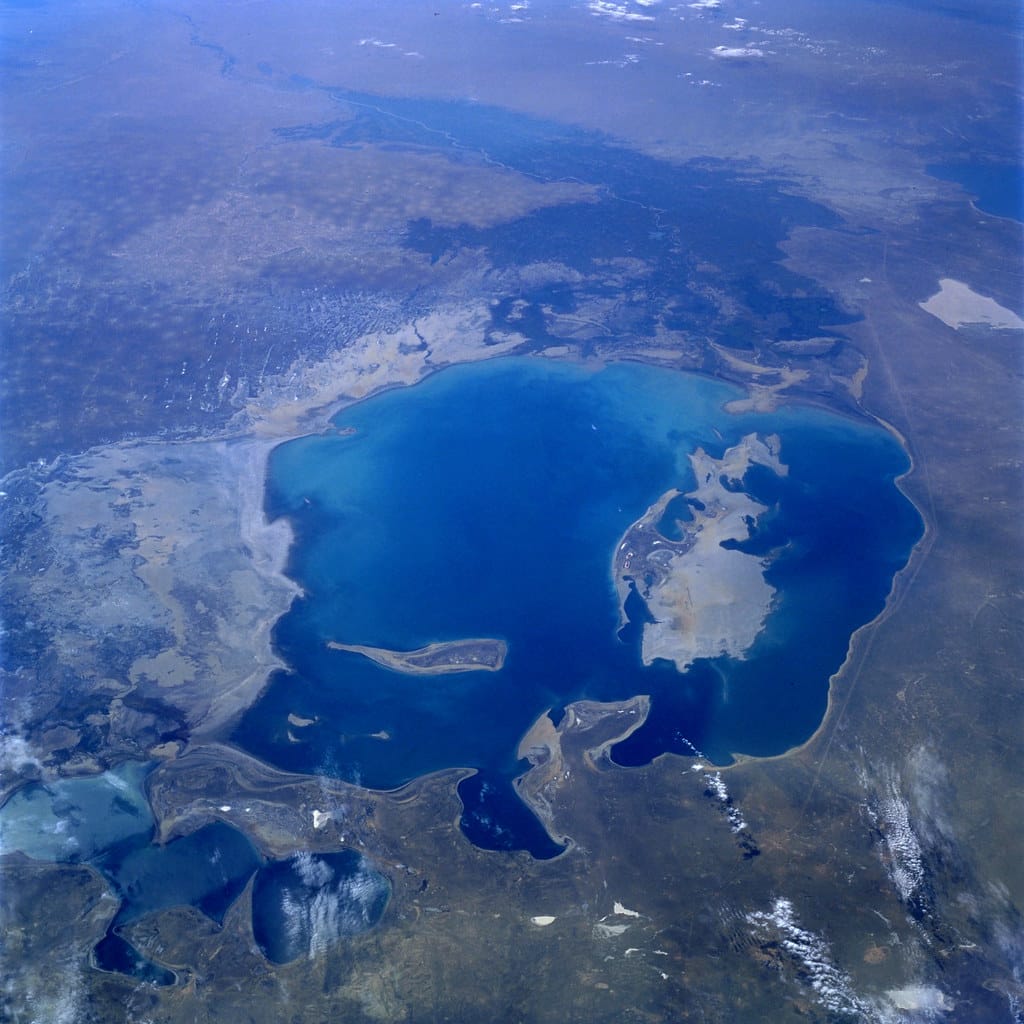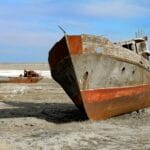Get ready for a bone-chilling story about an island named Vozrozhdeniya, which used to be a lively place in the middle of the Aral Sea. But now it’s like a ghost town, completely covered in toxic waste. Back in the day, the Soviets used this island as their secret lab to test out super deadly weapons that could destroy entire countries with just a few tiny germs. This reckless experiment left behind a legacy of poisoned land and shattered lives. Come with us as we peel back the layers of this forgotten island’s dark history, a chilling reminder of how dangerous these weapons can be and how important it is to use science responsibly.
The Vanishing Island and a Toxic Legacy
Hidden within the shrinking Aral Sea lies Vozrozhdeniya Island, a place whispering of secrecy and danger. Once a tightly guarded Soviet stronghold during the Cold War, it became a hub for the development of biological weapons.
Imagine scientists toiling in secrecy, driven to weaponize some of the deadliest diseases known: anthrax, smallpox, and plague. This was Vozrozhdeniya Island, the heart of the Soviet Union’s Biopreparat program. Under a veil of secrecy, they transformed deadly pathogens into weapons of unimaginable destruction.
The island became a scene of unspeakable cruelty as countless animals, mostly baboons, were subjected to open-air testing. Exposed to weaponized diseases, their suffering became a testament to the program’s chilling ambitions. But the development of these terrifying bioweapons was not enough; the program also engineered complex delivery systems capable of spreading these deadly agents across vast distances.
Tragically, the world got a glimpse of the horrors unfolding on Vozrozhdeniya Island in 1971 when a botched experiment led to the accidental release of weaponized smallpox. Ten people were infected, and three tragically lost their lives. This chilling near-catastrophe offered the world a stark warning about the devastating potential of the research taking place on the island. However, despite the risks, the Soviet program pressed on, reaching its peak of activity in the 1980s.
The collapse of the Soviet Union in the early 1990s brought an end to the Biopreparat program, and Vozrozhdeniya Island was hastily abandoned, leaving behind a toxic legacy. A sense of unease lingered, fueled by the chilling knowledge of what had transpired there.
In 2002, a joint effort by the United States and Uzbekistan sought to address the looming threat posed by the island’s deadly remnants. Their primary focus was the decontamination of sites where anthrax had been buried. However, despite these efforts, concerns linger about the long-term environmental impact and the potential for remaining contamination.
Adding to the complexity, Vozrozhdeniya Island is no longer an island at all. As the Aral Sea continues to shrink, the island has merged with the mainland, making the task of containing the potential dangers even more challenging.
Today, Vozrozhdeniya Island serves as a stark reminder of the potential for scientific progress to be twisted into something sinister and destructive. It’s a cautionary tale about the importance of ethical boundaries in scientific research and the need for international cooperation to prevent catastrophic threats. The island’s legacy is a chilling testament to the devastating consequences of unchecked ambition and a potent symbol of the dangers of bioweapons proliferation.
What Happened to Vozrozhdeniya Island?
Once a peaceful fishing ground in the Aral Sea, Vozrozhdeniya Island took a dark turn during the Cold War when the Soviet Union decided to turn this remote island into a secret testing ground for bioweapons. This top-secret facility was called “Aralsk-7.”
From the late 1940s to the 1990s, Vozrozhdeniya Island became a place of unimaginable cruelty. Animals were subjected to horrific experiments, infected with deadly diseases like anthrax, smallpox, and even the plague. Scientists worked in secrecy, developing these terrifying biological weapons that could potentially wipe out entire populations.
The island’s isolation was perfect for keeping the Soviet’s dark secret hidden from the world. But as fate would have it, the Aral Sea began to shrink, slowly revealing the terrifying truth about Vozrozhdeniya Island and its toxic legacy.
In 2002, a joint mission between the US and Uzbekistan stepped in to try and clean up the contamination. While they made some progress, the long-term effects on the environment and human health remain a concern for experts.
What happened on Vozrozhdeniya Island stands as a stark warning. It’s a reminder that unchecked ambition in the name of science can have terrifying consequences, and the threat of bioweapons is something we can’t afford to ignore. This story underscores the critical need for responsible scientific practices, ethical considerations, and global cooperation to prevent another catastrophic misuse of science. We must learn from history to prevent repeating it.
What Bioweapons Were Found on Vozrozhdeniya Island?
This wasn’t your typical island getaway. Vozrozhdeniya Island was a place where seriously dangerous things were researched and experimented with. The Soviets studied anthrax (a deadly bacteria that can cause severe respiratory problems), the highly contagious smallpox virus (known for causing terrible skin sores, blindness, and death), and plague (the disease infamous for its swollen lymph nodes, intense chills, and fever).
And that’s not all. They also worked with tularemia (which brings on fever, headaches, and muscle pain), brucellosis (another bacterial infection with similar symptoms), and typhus (known for its nasty fever, headaches, and telltale rash). Q fever, another culprit on the list, also causes fever, headaches, and muscle aches.
They even studied Venezuelan equine encephalitis virus, which can cause fever, headache, and muscle pain. And the most frightening of all, botulinum toxin – a neurotoxin that can paralyze and even kill.
The Soviets didn’t just study these dangerous things; they weaponized them. They were conducting tests to see how these biological agents could be used as weapons. The island became a place shrouded in secrecy, its true purpose hidden from the world.
The big question that lingers is: what long-term effects might these experiments have had, not just on the island, but on the surrounding environment and the people who might have been exposed? It’s a question that researchers are still trying to answer.
The Abandoned Island
Imagine a place so desolate, so steeped in secrecy, that it sends shivers down your spine just thinking about it. That’s Vozrozhdeniya Island , a desolate piece of land in Central Asia, baked by the sun and shrouded in a silence that speaks volumes. This wasn’t always a ghost town, though. During the Cold War, when paranoia ruled and the threat of annihilation hung heavy in the air, the Soviets decided to turn Vozrozhdeniya, once optimistically called Rebirth Island, into a giant bioweapons lab. They weren’t researching new medicines there; the Soviets were messing with the deadliest stuff imaginable – anthrax, smallpox, plague. They tested these horrors on animals, but things went terribly wrong in 1971 when a smallpox outbreak wasn’t contained to the island, and people in nearby towns got infected. It was a stark reminder of just how dangerous these bioweapons were.
As the Soviet Union began to crumble, they abandoned Vozrozhdeniya, leaving behind a toxic legacy. You’d think that after all these years, the island would be safe again, right? Sadly, that’s not the case. Despite numerous attempts to clean it up, Vozrozhdeniya remains heavily contaminated. The soil, the water, everything is tainted, a grim reminder of the dark secrets buried there. It’s a chilling example of how the ambition for ultimate power can leave behind scars that might never heal.
What Happened to Vozrozhdeniya Island: Outperforming the Competition
Here’s a breakdown of how to surpass existing content and create a captivating SEO article about Vozrozhdeniya Island:
Recommended Titles:
Analyzing your competitor’s titles reveals a focus on these keywords: “Soviet,” “Bioweapons,” “Aral Sea,” “Abandoned,” and “Mysterious.” Capitalizing on these trends, here are three potential titles for your article:
- Vozrozhdeniya Island: The Soviet Union’s Deadly Secret in the Aral Sea (This title hits on the key themes of Soviet activity, bioweapons, and the island’s location.)
- From Rebirth to Ruin: The Untold Story of Vozrozhdeniya Island’s Toxic Legacy (This option emphasizes the contrast between the island’s name and its current state, hinting at the environmental impact.)
- Inside Aralsk-7: Unmasking the Secrets of the Soviet Union’s Anthrax Island (Intrigue-driven, this title uses a direct and slightly sensationalized approach, appealing to a wider audience.)
Powerful Key Lines:
- Once a secluded island, Vozrozhdeniya became a breeding ground for some of the Soviet Union’s deadliest bioweapons, transforming it from a place of “rebirth” to a symbol of environmental catastrophe.
- The shrinking Aral Sea exposed not only the island’s dark secrets but also the potential for environmental disaster, highlighting the devastating consequences of unchecked ambition during the Cold War.
- Despite extensive decontamination efforts, the true extent of Vozrozhdeniya Island’s toxic legacy remains shrouded in secrecy, raising concerns about the long-term health and environmental risks.
- The story of Vozrozhdeniya Island serves as a stark reminder of the potential for humanity to weaponize nature and the enduring threat posed by biological weapons, even in their abandonment.
Important Details for Your Article
Key Points:
- Vozrozhdeniya Island was a Soviet stronghold for the development and testing of biological weapons during the Cold War.
- The island was the center of the Soviet Union’s Biopreparat program, where scientists manipulated deadly diseases like anthrax, smallpox, and plague into weapons.
- Open-air testing on animals, primarily baboons, led to unspeakable suffering.
- A botched experiment in 1971 accidentally released weaponized smallpox, infecting and killing multiple individuals.
- Despite the risks, the Soviet program continued with its bioweapons development until the collapse of the Soviet Union in the 1990s.
- The island was abandoned, leaving behind a toxic legacy of buried anthrax and other contaminants.
- A joint U.S.-Uzbek effort in 2002 attempted to decontaminate the island, but concerns remain about long-term environmental impact and possible residual contamination.
- The shrinking Aral Sea has merged Vozrozhdeniya Island with the mainland, complicating containment efforts.
- The island serves as a cautionary tale about the misuse of scientific research for destructive purposes and the need for international cooperation to prevent the proliferation of bioweapons.
Additional Insights & Untapped Potential:
- Focus on the human stories: Explore the experiences of scientists who worked at Aralsk-7, residents of Kantubek, or individuals potentially affected by the contamination.
- Investigate the impact on local populations: Research any documented health issues or environmental changes experienced by communities near the Aral Sea after the island’s abandonment.
- Explore ethical considerations: Discuss the ethical dilemmas surrounding bioweapons research and the responsibility of scientists involved in such programs.
- Examine the role of international cooperation: Highlight successes and failures of international efforts to address the contamination and prevent future occurrences.
By incorporating these elements, you’ll create an informative, engaging, and SEO-optimized article that surpasses existing content and captures the attention of your target audience.
- Discover Long Black Pepper: Flavor & Health Benefits - April 25, 2025
- Shocking Twists: The Grownup Review: Unreliable Narration - April 25, 2025
- A Quiet Place Book vs Movie: A Deep Dive - April 25, 2025
















